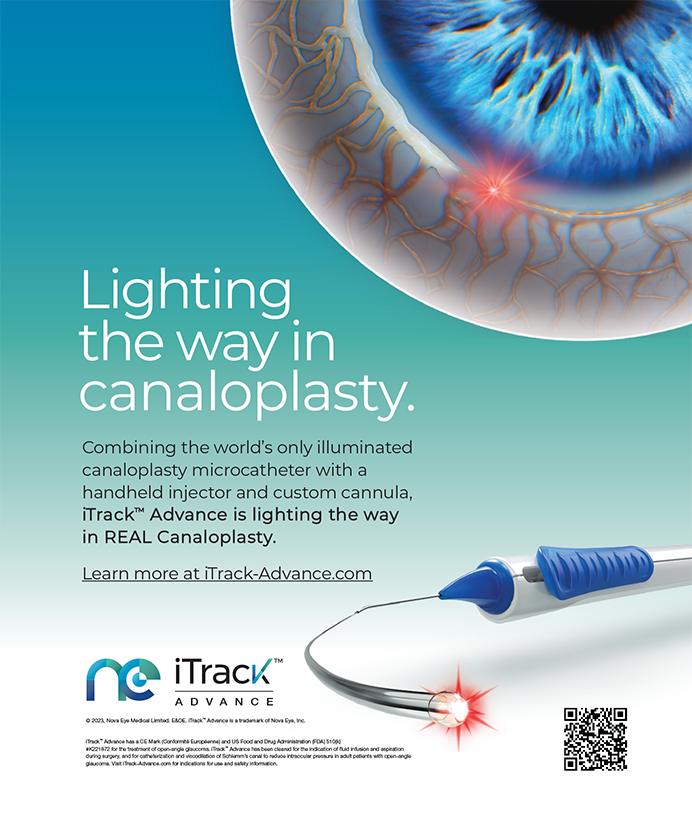
Clinical Outcomes and Complications Following Intraocular Lens Exchange in the Setting of an Open or Intact Posterior Capsule
Alsetri H, Masket S, Fram N, Sandoval H, Cabang J, McLachlan J1
Industry support: None
ABSTRACT SUMMARY
A nonrandomized, unmasked, retrospective chart review compared clinical outcomes and complications following IOL exchange in the setting of an intact or open posterior capsule (OPC). The study assessed 90 eyes of 75 patients who underwent IOL exchange for optical symptoms only. Eyes undergoing exchange owing to IOL malposition or dislocation, eyes with preexisting uncontrolled glaucoma and inflammation, and eyes with a visual potential worse than 20/40 were excluded.
Study in Brief
A nonrandomized, unmasked, retrospective chart review compared the clinical outcomes of IOL exchange in the setting of an intact versus an open posterior capsule. There was no statistical difference in complication rates between the groups.
WHY IT MATTERS
The study offers guidance to anterior segment surgeons facing the dilemma of whether to perform a capsulotomy or an IOL exchange to alleviate patients’ optical symptoms after cataract surgery.
Of the 90 eyes, 52 had a closed posterior capsule (CPC), and 38 had an OPC. In the OPC group, 33 of 38 eyes (87%) underwent an anterior vitrectomy at the time of IOL exchange. In most of the OPC eyes (57%), a three-piece IOL was placed in the ciliary sulcus with optic capture. Iris suture fixation or scleral fixation was performed when capsular support was inadequate. None of the patients in the CPC group required an anterior vitrectomy. Most of them (65%) underwent a bag-to-bag exchange; the original IOL was explanted, and a new IOL was implanted in the capsular bag. Compared to the OPC group, fewer CPC eyes (19%) required iris suture fixation. Seven had reverse optic capture.
Postoperative complications were minimal in both groups. Three and two eyes in the OPC and CPC groups, respectively, experienced worsening IOP control that required treatment with medications or selective laser trabeculoplasty. One eye in the OPC group experienced chronic inflammation for more than 3 months. Two eyes each in the OPC and CPC groups developed postoperative cystoid macular edema that resolved after treatment with topical steroids and NSAIDs. One eye in each group, however, had decreased corrected distance visual acuity due to chronic cystoid macular edema or vitreomacular traction. None of the postoperative complications reached statistical or clinical significance when compared between the OPC and CPC groups.
The refractive accuracy outcomes for the OPC and CPC groups were -0.70 and -0.41 D mean spherical equivalent, respectively. The difference was statistically significant (P = .003).
Alsetri and colleagues concluded that the rates of complications were not meaningfully different between the OPC and CPC groups but that refractive outcomes in the CPC group were superior.
DISCUSSION
The study takes aim at a dilemma that has long vexed anterior segment surgeons: Should an Nd:YAG laser capsulotomy be performed because the posterior capsule may be the source of a patient’s visual complaints, or should an IOL exchange be pursued because the optics may be the problem? Research has demonstrated increasing rates of IOL exchange. One study found that 5% of patients with diffractive IOLs required the procedure.2,3
Anterior segment surgeons often manage IOL complications. Most of them have encountered patients who have been told that they are stuck with their IOL because of a capsulotomy. I feel this is an unnecessary burden to place on patients. As Alsetri and colleagues conclude, “Patients needn’t be overly concerned about the added risks to IOL exchange for optical purposes should the posterior capsule be previously opened.”1 The investigators stated two important caveats. First, surgeons performing an IOL exchange in the setting of an OPC should be experienced and competent at executing a variety of anterior segment maneuvers, including an adequate anterior vitrectomy. Second, surgeons should be comfortable with multiple IOL fixation methods.
Surgical Management of Aphakia
Cheng KK, Tint NL, Sharp J, Alexander P4
Industry support: None
Cheng and colleagues reviewed current techniques to manage aphakia. The investigators searched the PubMed database for cohort studies of and new techniques for the management of aphakia published through February 2022. The search identified the most common techniques for aphakia correction, including anterior chamber, iris-claw, and sulcus IOLs with and without optic capture. The researchers also investigated more advanced scleral fixation techniques, including IOLs fixated with PTFE sutures (Gore-Tex, W.L. Gore & Associates); Hoffman scleral pockets5; the knotless Z-suture6; and the Scharioth,7 Agarwal,8 Yamane,9 and Canabrava10 techniques. The article concludes with a description of the Carlevale IOL for aphakia.
Study in Brief
The article provides a comprehensive review of the most common techniques for aphakia correction.
WHY IT MATTERS
Whether performing an IOL exchange or placing a secondary implant to correct aphakia, it is essential that surgeons have a thorough understanding of the various techniques when presented with these potentially challenging cases.
For each technique, Cheng and colleagues analyzed the available data on refractive outcomes, endothelial cell loss, lens tilt, endophthalmitis, uveitis-glaucoma-hyphema syndrome, retinal detachment, and other complications associated with aphakia correction. In some instances, they provided data from studies that explored the average time required to perform the technique. For example, the scleral fixation of a three-piece IOL required approximately 30 minutes less than a scleral suture technique.11
The article’s conclusions mirrored those of the AAO’s Ophthalmic Technology Assessment of 2020 in which multiple different IOL implantation techniques were associated with low complication rates when in-the-bag implantation was not possible.12 Additionally, Cheng et al concluded that there is no clear consensus or data to support primary or secondary IOL implantation.
DISCUSSION
Cheng and colleagues provide an excellent review of aphakia correction. The piece begins with a thorough discussion of sulcus anatomy—an important anatomic landmark that should be well known to any surgeon performing aphakia correction. Cheng and colleagues then investigated every imaginable method of implanting an IOL in an eye with a compromised capsular bag.
They also discussed the shortcomings of the various techniques. For example, the Yamane technique depends largely on access to the CT Lucia 602 IOL (Carl Zeiss Meditec) because its haptics are made of polyvinylidene fluoride, a resilient material that resists bending or breaking. The materials required for the Canabrava technique, in contrast, are commonly found at any hospital or ambulatory surgery center.
1. Alsetri H, Masket S, Fram N, Sandoval H, Cabang J, McLachlan J. Clinical outcomes and complications following intraocular lens exchange in the setting of an open or intact posterior capsule. J Cataract Refract Surg. 2023;49(5):499-503.
2. Abdalla Elsayed MEA, Ahmad K, Al-Abdullah AA, et al. Incidence of intraocular lens exchange after cataract surgery. Sci Rep. 2019;9(1):12877.
3. Wilkins MR, Allan BD, Rubin GS, et al; Moorfields IOL Study Group. Randomized trial of multifocal intraocular lenses versus monovision after bilateral cataract surgery. Ophthalmology. 2013;120(12):2449-2455.e1.
4. Cheng KKW, Tint NL, Sharp J, Alexander P. Surgical management of aphakia. J Cataract Refract Surg. 2022;48(12):1453-1461.
5. Hoffman RS, Fine IH, Packer M. Scleral fixation without conjunctival dissection. J Cataract Refract Surg. 2006;32(11):1907-1912.
6. Szurman P, Petermeier K, Aisenbrey S, Spitzer MS, Jaissle GB. Z-suture: a new knotless technique for transscleral suture fixation of intraocular implants. Br J Ophthalmol. 2010;94(2):167-169.
7. Gabor SG, Pavlidis MM. Sutureless intrascleral posterior chamber intraocular lens fixation. J Cataract Refract Surg. 2007;33(11):1851-1854.
8. Agarwal A, Kumar DA, Jacob S, Baid C, Agarwal A, Srinivasan S. Fibrin glue-assisted sutureless posterior chamber intraocular lens implantation in eyes with deficient posterior capsules. J Cataract Refract Surg. 2008;34(9):1433-1438.
9. Yamane S, Sato S, Maruyama-Inoue M, Kadonosono K. Flanged intrascleral intraocular lens fixation with double-needle technique. Ophthalmology. 2017;124(8):1136-1142.
10. Canabrava S, Canêdo Domingos Lima AC, Ribeiro G. Four-flanged intrascleral intraocular lens fixation technique: no flaps, no knots, no glue. Cornea. 2020;39(4):527-528.
11. Do JR, Park SJ, Mukai R, Kim HK, Shin JP, Park DH. A 1-year prospective comparative study of sutureless flanged intraocular lens fixation and conventional sutured scleral fixation in intraocular lens dislocation. Ophthalmologica. 2021;244(1):68-75.
12. Shen JF, Deng S, Hammersmith KM, et al. Intraocular lens implantation in the absence of zonular support: an outcomes and safety update: a report by the American Academy of Ophthalmology. Ophthalmology. 2020;127(9):1234-1258.




